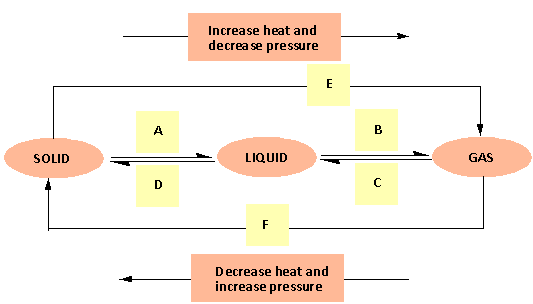
Name A, B, C, D, E and F in the following diagram showing change in its state.


Answer
548.4k+ views
Hint: To solve this we must know the various terms that are used for the conversion from one physical state to another. In the given diagram, the interconversion of three states of matter i.e. solid, liquid and gas is shown. Matter can be converted from one state to another by increasing or decreasing temperature and pressure.
Complete step-by-step answer:
In the given diagram, the interconversion of three states of matter i.e. solid, liquid and gas is shown.
We know that by increasing the heat and decreasing the pressure we can convert solid to liquid and liquid to gas. Similarly, by decreasing the heat and increasing the pressure we can convert gas to liquid and liquid to solid.
A is conversion of solid to liquid. When a solid is converted to a liquid by increasing the heat and decreasing the pressure it is known as fusion. Thus, A is fusion.
B is conversion of liquid to gas. When a liquid is converted to a gas by increasing the heat and decreasing the pressure it is known as vaporisation. Thus, B is vaporisation.
C is conversion of gas to liquid. When a gas is converted to a liquid by decreasing the heat and increasing the pressure it is known as condensation. Thus, C is condensation.
D is conversion of liquid to solid. When a liquid is converted to a solid by decreasing the heat and increasing the pressure it is known as solidification. Thus, D is solidification.
E is conversion of solid to gas. When a solid is converted to a gas by increasing the heat and decreasing the pressure it is known as sublimation. Thus, E is sublimation.
F is conversion of gas to solid. When a gas is converted to a solid by decreasing the heat and increasing the pressure it is known as deposition. Thus, F is deposition.
Thus,A-fusion, B-vaporisation, C-condensation, D-solidification, E-sublimation and F-deposition.
Note: Remember the terms fusion, vaporisation, condensation, solidification, sublimation and deposition. Fusion, evaporation and sublimation can be done by increasing in heat and decreasing the pressure. And condensation, solidification and deposition can be done by decreasing the heat and increasing the pressure.
Complete step-by-step answer:
In the given diagram, the interconversion of three states of matter i.e. solid, liquid and gas is shown.
We know that by increasing the heat and decreasing the pressure we can convert solid to liquid and liquid to gas. Similarly, by decreasing the heat and increasing the pressure we can convert gas to liquid and liquid to solid.
A is conversion of solid to liquid. When a solid is converted to a liquid by increasing the heat and decreasing the pressure it is known as fusion. Thus, A is fusion.
B is conversion of liquid to gas. When a liquid is converted to a gas by increasing the heat and decreasing the pressure it is known as vaporisation. Thus, B is vaporisation.
C is conversion of gas to liquid. When a gas is converted to a liquid by decreasing the heat and increasing the pressure it is known as condensation. Thus, C is condensation.
D is conversion of liquid to solid. When a liquid is converted to a solid by decreasing the heat and increasing the pressure it is known as solidification. Thus, D is solidification.
E is conversion of solid to gas. When a solid is converted to a gas by increasing the heat and decreasing the pressure it is known as sublimation. Thus, E is sublimation.
F is conversion of gas to solid. When a gas is converted to a solid by decreasing the heat and increasing the pressure it is known as deposition. Thus, F is deposition.
Thus,A-fusion, B-vaporisation, C-condensation, D-solidification, E-sublimation and F-deposition.
Note: Remember the terms fusion, vaporisation, condensation, solidification, sublimation and deposition. Fusion, evaporation and sublimation can be done by increasing in heat and decreasing the pressure. And condensation, solidification and deposition can be done by decreasing the heat and increasing the pressure.
Recently Updated Pages
Why are manures considered better than fertilizers class 11 biology CBSE

Find the coordinates of the midpoint of the line segment class 11 maths CBSE

Distinguish between static friction limiting friction class 11 physics CBSE

The Chairman of the constituent Assembly was A Jawaharlal class 11 social science CBSE

The first National Commission on Labour NCL submitted class 11 social science CBSE

Number of all subshell of n + l 7 is A 4 B 5 C 6 D class 11 chemistry CBSE

Trending doubts
Differentiate between an exothermic and an endothermic class 11 chemistry CBSE

10 examples of friction in our daily life

One Metric ton is equal to kg A 10000 B 1000 C 100 class 11 physics CBSE

Difference Between Prokaryotic Cells and Eukaryotic Cells

1 Quintal is equal to a 110 kg b 10 kg c 100kg d 1000 class 11 physics CBSE

State the laws of reflection of light




